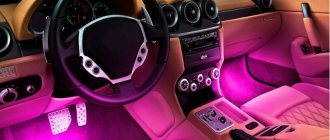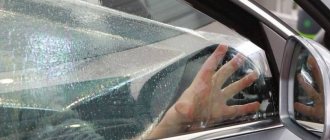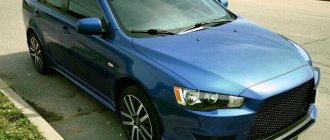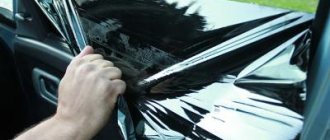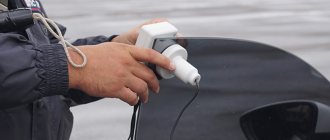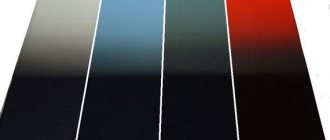Athermal tinting is the only comfortable way to overcome the heat and bright sunlight. Now many automakers equip their cars with athermal glass. “Chameleon” is one of the varieties of athermal tinting, and its only difference is the ability to change light transmission depending on the brightness of the sun.
The athermal film is heterogeneous. It consists of several layers. First there is a protective coating (A), then an adhesive layer (B), capable of absorbing UV radiation, followed by a transparent layer (C, also called tinted), which also has this property. The metallized layer (D), in addition to reflecting thermal energy, has one more property - the metal oxides it contains determine the color of the tint: usually greenish or blue-violet. The penultimate layer is a polyester transparent layer (E). The last one is anti-scratch (F).
Due to such a complex structure, athermal film becomes quite expensive. Despite this, many manufacturers are trying to introduce this film into their cars.
Modern technologies allow athermal film to transmit most of the light flux, while maintaining the light transmittance of the glass. Also, the athermal film prevents the formation of glass fragments in the event of an accident, which increases the safety of the driver and passenger in the front seat. The film reduces the deformation of plastic parts of the interior and allows you not to use air conditioning. Another important advantage of tinting is a significant reduction in the rate of aging of leather elements in the cabin, especially for seats.
Important information
Despite the fact that the film blocks UV and IR radiation, this protection is not absolute. Chameleon film can be used to tint not only the rear and side windows, but also the windshield of a car.
At the same time, technical standards are not violated. The use of film allows the driver to protect the interior from overheating and fading of seats under the influence of the sun's rays. The load on the interior air conditioning system is also reduced.
From January 1, 2021, the requirements for tinting car windshields have been tightened. Using the film, you need to make sure that the view of the road is not impaired.
Basic Concepts
Athermal film consists of twenty different, very thin layers. They are applied one on top of the other using the magnetron sputtering method.
The main feature of this tint is that it is not noticeable under normal lighting and only appears when exposed to sunlight.
Magnetron sputtering is a technology used in the manufacture of tinting. Several layers of film are applied to the substrate using cathode sputtering, each of which gives its own shade.
A car with chameleon tinting installed on its windows takes on an unusual look. It also provides protection for all passengers of the car in the event of an accident - glass fragments are retained by the film and do not scratch the people sitting in the cabin.
What is its function
Chameleon film has the following features:
- Durability - the film does not fade even in bright sun and remains transparent for a long time.
- Light transmittance is maintained within 90 percent.
- Provides protection for the interior from exposure to UV rays.
- The strength of car window glass increases. Even with a powerful impact, the fragments do not scatter throughout the cabin, but are retained by the film, which reduces injuries in the event of an accident.
- The glass is protected from various scratches and cracks.
- Beautiful appearance - in the sun the film shimmers with different colors of the rainbow.
- Under halogen lighting, the film becomes transparent.
When purchasing film, you should pay attention to its compliance with GOST standards. Since chameleon film has high light transmittance, the car will pass inspection, and the driver will not receive a fine when the car is stopped by a traffic police inspector
Legal basis
Regulatory acts establishing standards for the use of car tint films:
| Decree of the Government of the Russian Federation No. 1090 - Traffic rules | The legal document outlines the rules of the road, as well as the features of using car tuning |
| Federal Law No. 195 - Code of Administrative Offenses | The amount of fines for violating vehicle tinting rules has been established |
| Federal Law No. 307 | Lists amendments made to the Code of Administrative Offenses of the Russian Federation |
In addition, the driver must take into account the standards given in the State Standard GOST, which states that the light transmittance of glass must be at least 80 - 85%.
Permissible percentages
In addition to its beautiful appearance, tinting also has a practical component. In the event of an accident or a stone hitting the glass, it will not shatter into small pieces with the risk of injuring passengers. The film (but not every one) will protect from ultraviolet radiation and direct sunlight. Some films will help reduce the temperature in the cabin by several degrees, and keep you warm in cold weather.
The degree of shading of the tint is measured as a percentage. The lower the number, the darker the film. With a light transmission of 50-100%, it is almost impossible to determine the presence of tint by eye. According to current legislation, you have the right to use 75% of the film or lighter for the windshield, and 70% or more for the front side windows (no one can see it). Therefore, “by law” it makes sense to glue only a transparent athermal film to the front windows, which will at least protect from the sun and heat. It is allowed to place a dark stripe at the top of the windshield, but such tinting is allowed to be placed at a height of no wider than 14 cm.
Tinting films with a low percentage of light transmission not only protect the car from prying eyes, but also significantly impair visibility at night
Rear windows can be tinted at your discretion, only mirror films are not allowed. 5, 10 and 15 percent darkness will not allow you to see anything in the car. At 20-35%, silhouettes can already be distinguished. Please note that it will also be worse to see from the inside (especially at night and with cheap films).
These standards are regulated by GOST 5727-88 and certain conditions are required to verify compliance:
- air temperature from -10 to +35 degrees;
- humidity not higher than 80%;
- taumeter (measuring device) with documents and seal.
Consider not only the beauty of appearance, but also compliance with the current norms of the Code of Administrative Offenses
The penalty is 500 rubles until a new law is adopted. Rooms will not be removed for such a violation. Tricks with removable tinting do not exempt you from liability
Therefore, if you are caught with dark windows, it doesn’t matter whether the “shooting” is glued all around or only a couple of front windows are glued, you will still have to pay
Why do you tint a car?
Many drivers tint their car not only for aesthetic purposes, but also for practical ones, because in a tinted car the interior fades less and it is comfortable to drive in sunny weather.
Partial tint film protects passengers from ultraviolet radiation and creates a unique microclimate in the cabin.
Also, do not forget about safety, because glass covered with tinting film is less susceptible to splitting upon impact.
Tinted glass, as it were, isolates passengers from the outside world and does not allow others to look into the interior for the sake of simple curiosity.
And the desire of drivers to stand out from the surrounding stream of cars dispels all remaining doubts about whether to start looking for a tint film or not.
Based on the above, we can draw a small conclusion - the choice of tint film must be approached responsibly and correctly, because it is not applied for one day.
Caring for athermal windshields in winter
Caring for car windows in winter requires a special approach. If you do not follow the established rules when cleaning, you can damage the glazing and render it unusable.
Russian winter is famous for its severity and severe frosts, so during this season you must always have a special defrosting product in your car. Without it, you will not be able to remove ice from the windshield glass surface, or open a frozen lock.
Important!
Never use brushes or scrapers to remove ice from the glass surface! It is impossible to do this without damaging the coating - scratches will form on the glass. In addition, scraping ice in this way is a very thankless task - after spending a lot of time and effort, you will not achieve a positive result.
If using an ice scraper was absolutely necessary, try polishing the glass surface at the end of winter to remove or at least smooth out the scratches. Although the best solution would be to simply avoid this situation.
The best way to clean an icy windshield is to turn on the heater in the cabin; warm air will easily melt the ice crust. If necessary, you can also use the defrost mentioned earlier.
Don't forget about caring for your wipers. In winter, due to exposure to low temperatures, they wear out faster and therefore require special attention. It is recommended to clean the windshield blades at least 2 times a day. It is best to carry out the manipulation using warm soapy water. On particularly frosty nights, it is recommended to remove and take the wipers with you.
Ordinary wipers are not adapted to harsh winter conditions, and therefore an excellent solution would be to purchase special “seasonal” winter brushes. Thus, you will extend the life of your windshield, increase your level of safety and save your nerve cells.
Tinting methods
There are several ways to tint a plastic window:
- Ready-made tinted glass can be purchased before installing a double-glazed window. It is manufactured at the factory with the addition of the desired dye.
- Spray a tint layer onto hot glass. When watching video tutorials, you can quickly figure out how to darken a window in this way.
- Vacuum tinting is performed at the factory.
- Using adhesive film is the easiest and cheapest way you can do it yourself. It’s not difficult to implement, just choose the appropriate shade.
How to distinguish from ordinary
To distinguish real athermal material from simple glass, you need to know a few tricks. Unscrupulous sellers have found a way to profit from naive buyers - they sell ordinary glass with athermal film, passing it off as real athermal anti-reflective glass. When purchasing, ask for a certificate for the product, and also check the stamps and logo. Please note the manufacturer. Unknown name? Fake. Check the edge. Irregularities or chips? Fake.
Seeing the difference between the original and the fake is a great art. But it can save you from wasting money.
Work order
Pasting a vehicle with film material is carried out in several stages:
- First, debris, sand, dust and other elements are removed from the surface of the paintwork.
- All elements that are planned to be pasted over are degreased with special chemical solutions.
- Then the body parts are dried with industrial fans.
- Now comes the time-consuming stage - direct gluing with polyurethane film. To do this, use a soap solution and maintain a positive temperature regime. The film is tightly applied to the surface and gradually smoothed to remove air bubbles. Some experts use ordinary water, but the foam prevents the film from sticking, and if a wrinkle forms, it can be easily lifted and rolled again. A samurai polyurethane film knife is very useful in your work; it is one of the most important tools for any specialist.
Pasting and polishing polishing polyurethane film
About making changes to the design
As I said above, any actions with the car are changes to the design. But not all of them need to be registered with the traffic police. The following are not registered.
- Changes when non-original spare parts or pieces of equipment certified as part of this vehicle are installed on a vehicle. The simplest example: installing non-original wipers. It is enough that the wiper packaging indicates that they have been certified as part of your car.
- Provided in the operating instructions. An equally simple example is installing a radio in a car.
- If the athermal film has been tested as part of your car, as stated in the certificate attached to the film, or the application of tinting is provided for in the operating instructions for your car, then you do not need to register it with the traffic police and it is permitted provided the light transmittance of the window is at least 70%. Otherwise, you need to go all the way to register changes to the design.
Will they issue a fine?
It is highly likely that there will be no fine for unregistered changes. The procedure for proving an offense in this case is quite complicated:
- in full accordance with the law, it is necessary to initiate an administrative investigation,
- collect the necessary evidence,
- then – consideration of the case in court.
No one in the traffic police will waste time on this.
In conclusion, when I have an unbridled desire to experiment with the car, I go to the store and buy new windshield wipers. First of all, it's cheap. Secondly, replacing them yourself is not difficult. And thirdly, I feel a feeling of complete satisfaction from the work I did with my own hands.
Types of darkening by application technology
There is a distinction between removable, when films are used, and permanent - these are electronic sputtering technologies. Motorists install striped glass or glass that changes transparency (“chameleon”).
The degree of darkening is regulated by GOST standards and is measured by a tool - a taumeter. Motorists must adhere to the following rules:
- Front window dimming no more than 25%.
- The degree of tinting of the sides is no more than 30%.
- Color tinting of car windows is allowed.
- The degree of shading of the rear windows is not regulated, provided that at least two side mirrors are installed.
Removable toning
Low price and ease of installation are the advantages of removable windshield tinting. You can stick it on any area yourself and quickly remove it. Types of car window tinting:
A tint film is applied to the plastic base and installed with tape. The material is easy to remove and is resistant to temperature changes.
The silicone analogue is fixed with a special chemical composition and has a small thickness. It is better to install silicone tint in a workshop if the driver does not have experience.
The main disadvantage of this option is its short service life, less than 3 months. Among the advantages:
- low price of material;
- ease of installation and removal;
- the ability to choose any shade to match the main color of the car.
Electronic tinting
This method has a second name - smart tinting. A layer of sputtering is applied to the glass surface through electromechanical action. After processing, individual areas of the glass may be lighter or darker, and the angle of light refraction may change depending on the ambient temperature.
Electric tinting complies with GOST and does not give specular reflections. Glass processing requires special equipment and is carried out in car services. Among the disadvantages of electronic glass tinting, the price is noted - from 10,000 rubles per square meter.
Sputtering
Spraying remains a popular method of darkening the interior. Glass is processed in a vacuum chamber, where under pressure a layer of metal particles or polymers is applied to it. The procedure is only possible using the equipment in the services.
Sputtering as nanotinting has significant disadvantages:
- Spraying defects cannot be corrected or removed. When replacing, you will need to install a windshield.
- The price for spraying in services that provide a guarantee for the work performed is at least 10,000 rubles per square meter.
- At temperatures below 15 °C, the composition may crack, since the applied material has a different compression ratio and density.
- A mirror effect may appear in sunny weather, which will always be regarded by the traffic police inspector as a violation of the rules.
Film coating remains the most common type of glass tinting due to its ease of installation, ease of dismantling, and a wide range of darkening compounds.
What kind of glass is called duplicate?
Duplicates are classified as ARG (automotive replacement glass) - this means that the product imitates the original. Original auto glass is much more expensive.
A duplicate is a product that imitates the original, made according to good patterns, but with deviations according to various criteria. Non-original ARG auto glass may not have the same molding, dimple, rain and light sensor on the glass. Otherwise, non-original glass can sometimes be as good as the original glass. Such glass is usually produced on modern equipment using good polished glass. On non-original glass you will never find the automaker's logo, only the name of the auto glass brand.
What to choose - original or duplicate?
The original is the ideal option, maximally meeting all standards and parameters. If the price suits you, take it. However, the price for original glass is often several times higher than for analogues.
Installing duplicate glass on your car is not something scary or surprising, because according to our statistics, 95% of car owners choose a duplicate. However, it should be borne in mind that duplicates also come from different brands and may differ in quality. There are European, Japanese, Chinese, Russian, costing from 1,500 to 150,000 rubles.
What are the disadvantages of duplicate glass?
— Possible reduction in the value of the car upon sale. A potential buyer can point out the fact that the windshield was replaced with a non-original one. However, the windshield is now considered a consumable and is replaced very often.
— Distortions are possible. All duplicate glass has tolerances for distortion, but they must comply with GOST.
— Deviations in geometry are possible. All duplicate glasses are made according to the dimensions of the original glass with permissible deviations. This means that the glass may be several millimeters smaller or larger than the original, or have a slightly different curve. In most cases, this is not noticeable to the eye and does not affect the quality of the installation.
— Possible lack of components. Some windshields must be equipped with additional moldings and bases for a rain sensor. Cheap duplicates usually don’t have this; you have to buy extra.
Bottom line: You can install both original and duplicate glass on your car. Consider your budget and the process of operating the car - if you often drive on the highway, then installing expensive original glass may not be the best idea. At the same time, you should not hope that a duplicate windshield for 2-3 thousand rubles will be of the same quality as one for 8-10.
© Euroglass ® Company 2000 - 2021 EuroGlass-Ekaterinburg LLC 620072, Ekaterinburg, st. 40th anniversary of Komsomol, 38D INN 6670018910, checkpoint 667001001
What types of tint films are there?
It is most convenient to classify tint films by their type (type), which is characterized by the material from which it is made. Let's look at each of them in more detail and find out which film for tinting car windows is better.
The main types of tinting films for cars:
- Metallized tint film;
- Color tint film for cars;
- Tinting film with color transition;
- Infinity tint film (mirror tinting);
- Carbon film for cars.
Tinted metal or coated with film photo
This type of film would be the best choice if your primary concern is limiting interior heat and burnout. A special feature of this tint is a thin aluminum coating that reflects the sun's rays well. Aluminum gives the material a metallic sheen, from which the name comes. A significant disadvantage is that such tinting interferes with the passage of signals, so mobile communications in the car will work unstably.
Tinting glass color film
Films of this type are the most common. They consist of several microlayers of different shades, the overlap of which gives a certain color. They have an affordable price, and a variety of colors allows you to choose a film to suit the taste of every car enthusiast. Due to the absence of metal in the composition, there will be no interference with mobile communications, but such material reflects the sun’s rays worse and also wears out much faster compared to analogues.
Tinting film with color transition
Not everyone will like a film with a color transition for cars. If you paste it over glass, it will become multi-colored, because the material consists of two parts with a smooth transition: a metal coating at the top and an ordinary colored part at the bottom. From inside the car, the top of the glass simply looks darker than the bottom. This combination allows you to get rid of sun glare and at the same time maintain excellent visibility, as a result of which the film is very practical, but looks ambiguous from the outside.
Tinting film infi thread photo
Also known as mirror tint. In fact, a variation of metallic - aluminum coating is on the outside, and not between layers of colored film. As a result, it is noticeably stronger and reflects the sun better than metallized film. It darkens the interior almost without compromising visibility, but is more expensive due to the higher production cost than metallic, and also glares strongly from the outside (in the dark) when light hits it, which can cause an emergency.
Carbon car wrap
oh film
And so we answer your question, which film for tinting car windows is better? – carbon film for cars is the most high-tech at the moment. Its design uses a microlayer of graphite sprayed in a vacuum. As a result, very high characteristics are achieved: reflection of sunlight and heat at the level of metallized films in the complete absence of interference and glare, resistance to ultraviolet radiation and fading, long service life. And if you want to buy a carbon film for a car in Moscow, then it immediately has a big disadvantage - it is a high price and a limited number of car services where you can tint a car with its help.
Pasting process
You can glue the armor yourself with a minimal set of tools. To improve quality, you should prepare your car and workplace. Work is carried out in a warm room with a minimum amount of dust.
Covering glass with film may take several days. The final result and the time spent on the work depend on the skill of the car enthusiast and the quality of the material.
The technology for applying different types of materials to glass is no different, but armored material is more difficult to smooth out and achieve a smooth surface.
Preparation
The side windows are dismantled for ease of work or left in frames if you have the skill in gluing. Windshield is the most difficult to apply due to its semicircular shape, mirror mount and large area.
To get the hang of it and get better at armoring or tinting, you should start with small side windows.
Preparing the windshield and rear deflector:
- Remove the plastic covers on the racks.
- Remove the mirror, brake light and accessories.
- Wash the surface thoroughly.
- Degrease the shield and wipe with microfiber to prevent hair and small dust particles from getting under the film.
The anti-shock film can withstand heavy loads, but regular tinting can tear during smoothing if a small grain of sand gets in. Before gluing, you should carefully inspect the surface and remove small particles.
Cutting out the template
Armor film for glass is glued in the same way as tinting. Due to its durable composition, it is more difficult to trim on site, so you should take a responsible approach to marking the edges and making a template.
How to cut film correctly:
- Wipe the outside of the window.
- Cut a piece of film with a margin of 5-7 centimeters.
- Wet the window with soapy water.
- Attach the material to the shield with the adhesive layer facing out.
- Wet the film.
- Smooth it out with a spatula.
- Carefully trim the edges along the outer elastic bands.
The finished template can be removed and placed in place with the blanks so as not to confuse it when gluing it.
When applying the film, it is important to clarify where the adhesive layer is located and turn it outward. Otherwise, the template will be for the opposite window
To make it easier to make a pattern for the windshield, lift the brushes and secure the upper edges of the film with magnets on the roof. In places of bends, the material is heated with an industrial hair dryer and smoothed to a tight fit.
The impact-resistant film consists of a dense material. To quickly trim the edges and avoid leaving burrs, you should use a sharp blade with a comfortable handle. You can purchase such a tool at a hardware store.
Pasting the film
To avoid the appearance of bubbles, streaks and cloudy spots, work should be carried out in a clean, warm room.
The film is glued to the windshield of a car as follows:
- We treat the surface with soapy water from a spray bottle.
- Peel off the protective coating from the material.
- We apply the car film to the shield and align it with our hands.
- We start collecting water from the center of the glass and move towards the edges.
- Gradually glue the material to the surface.
After leveling the material, the surface can be heated with a hairdryer to evaporate the water and dry quickly. Windows should not be touched, wiped or opened for 24 hours. During work, the panel is covered with newspapers or cloth to protect it from getting wet.
Applying armor to side windows is no different from covering a windshield. With the glazing removed, the task is greatly simplified
When installing glass, be careful not to damage the material with metal rods.
Using film on a car allows you to improve the appearance, protect the interior from heating by the sun and the penetration of intruders. Self-pasting is in no way inferior in quality to work done in a specialized service. If the requirements are met, excellent results are obtained with minimal investment.
What athermal film is acceptable?
Athermal tinting is conditionally permitted, but it can be applied to glass only if a number of rules are observed, which some manufacturers neglect.
Most often the question arises whether it is allowed to glue athermal film to the windshield. Yes, but its light transmittance level should not be lower than 70%. You will have to spend time taking measurements, but if the car is new, the efforts will be justified - the standard result after installing the film is 76.5% light transmittance, which corresponds to the norm. After several years of active use, the glass may become cloudier, so it is recommended to repeat measurements periodically.
Athermal tinting “Chameleon”, capable of changing light transmission depending on the intensity of light, often reflects quite strongly, so the driver may face problems when passing the test. This feature of “Chameleon” is due to the fact that this type of film consists of many metallized layers, which not only change the color of the tint, but also mirror the image.
This film may have different light transmittance depending on the time of day and temperature. Indicators may also vary across the width of the film. It is thanks to these features that the “chameleon” effect is achieved. Unfortunately, models of the domestic automobile industry and inexpensive foreign cars with chameleon film will not comply with the standards established by law, especially if they have been in use for more than one year, and there are cracks or cloudy areas on the glass. There is only one way out - replace the glass with new ones.
Purple athermal tint is most often installed on the rear window because it darkens the windows significantly. It is only allowed to be glued to windows with a light transmittance of at least 91%. This indicator can only be found in new glasses. In addition, the result largely depends on the quality of installation. In the worst case, the scatter can reach 7% in different areas of the glass.
Is there a penalty for installation
According to GOST, permitted tinting transmits more than 70% of sunlight without a mirror effect. This means that there is no fine for installing athermal glass on a car if it complies with the law. Only the front side windows and windshield are adjustable. But athermal film, which transmits less than 60% of the light, begins to mirror. This is not allowed on any window.
The fine for incorrect tinting is 1,500 rubles. In case of repeated violation, the amount increases to 5000.
Pearl or mother-of-pearl film.
Pearl, also known as mother-of-pearl film on cars, is a type of chameleon-colored vinyl. The main difference between pearl film and chameleon is the main color. To be more precise, the pearl-like film is white. Auto vinyl chameleon, in turn, is dark, with shades of burgundy, blue, green, purple and even black. But just like a chameleon film, pearlescent vinyl can change its color depending on the viewing angle.
Pearl film is usually represented by glossy vinyl and much less often matte. Pearl-colored vinyl perfectly copies the color of natural mother-of-pearl. In the light, such a film shimmers from light pink to light green and other shades. As a rule, white cars are covered with this vinyl, which makes them even more beautiful. White pearlescent film can be combined with regular chameleon-colored car vinyl. With this combination, a significant contrast is achieved between dark and light tones. The sides are covered with chameleon film, and the bumper, hood, roof and trunk are covered with mother-of-pearl. This is a classic combination, like black and white vinyl, only here they use films that can change their color, which looks much more interesting.
How to produce
Athermal glazing is produced using special equipment. Anti-reflective glasses in pale green or pale blue are marked in the upper right corner with the stamps “Overtinted” or “Tinted”. Markings differ in the percentage of light transmittance: Overtinted transmits 81% of rays, and Tinted 3% less.
Each manufacturer produces glass differently, so they can have different shades: from brownish to purple. Athermal options with chameleon colors have beautiful iridescence and are becoming more and more popular on the market.
The best manufacturers of premium tint film
Shadow Guard
The company, originally from South Korea, sells black and athermal films. The PHP CHAORACAL series is highly popular - a unique combination of metal and ceramics. The product can be molded.
Shadow Guard tint film
Advantages:
- service life - 10 years;
- anti-abrasive coating;
- thickness - 38 microns;
- Blocks up to 99% of ultraviolet rays.
Flaws:
- too expensive;
- not the most common product.
SunTek
One of the main competitors of Llumar. On many automotive forums, discussions continue about who is better. Users note that after installation, the temperature in the cabin significantly decreases and the efficiency of climate control increases. The material enhances the strength of glass. The coating prevents scratches and chips and will retain its original appearance for a long time.
SunTek tint film
Advantages:
- does not fade;
- does not obstruct the view
- much thinner than competitors;
- long service life.
Flaws:
- supply problems often arise;
- overcharge;
- difficulty to install.
LLumar
The undisputed leader in the market. The Eastman Chemical company was opened back in 1920. The Llumar trademark was registered after the development of an innovative technology for producing colored polyethylene terephthalate. A wide range and strict control helped the company gain recognition. The product does not fade and lasts for 6 years. The addition of metal particles increased the strength.
LLumar tint film
Advantages:
- operation for many years;
- good visibility;
- reliable protection against UV rays;
- a brand that needs no introduction.
Flaws:
- not affordable price;
- the product is often counterfeited.
The top list represents the best companies in a specific market segment. Having chosen one of them, you don’t have to worry that the product will not be of adequate quality. They act as a standard of excellence and this is confirmed by numerous positive reviews from those who have already used the products.
Nuances of choice: how to cover the rear and front windows of a car
Having decided on your attitude to GOST and its standards, you can proceed directly to choosing an option for yourself. Please note that the glass itself does not transmit 100% of the light (usually 90-95%). Before installation, it is advisable to take a small piece of material and check the total light penetration rate with the device.
Let's start with the "state employees". If finances are very limited, then you can even look towards Chinese film. Just don’t glue it yourself - you’ll suffer, use the services of pasters (you can then demand that the defects be eliminated from them). If you are consciously prepared for a short service life and gradual loss of color, this may be your option.
Dyed films from “famous” manufacturers from the previous section are distinguished by better strength and ease of gluing than Chinese ones. You can choose a more expensive film and edit it yourself. For the same money you will get a better quality car product.
The next “level” includes all types of metallized films: color, gradient or simply black. In addition to changing the appearance, the “load” includes protection from ultraviolet rays and good wear resistance (you can count on 5–6 years). True, you will have to pay extra for these properties. Good craftsmen can apply almost any design to color film (at the same level as airbrushing). If you are willing to pay an extra +30% for a higher quality product, take a tint film made using spatter technology.
Don't forget that the rear windows of a car are still intended for something. Or at least get a panoramic rearview mirror
Athermal film is suitable for practitioners who decide to comply with the law. Transparency allows you to completely cover the windshield and front windows. A high-quality “athermal” retains up to 90% of heat from the sun’s rays. Many people note that after installation they began to turn on the air conditioning much less often. This is achieved through multi-layering (up to 20 layers, depending on the manufacturer). Each layer blocks a specific narrow spectrum of ultraviolet and infrared rays. Naturally, such complex technology leads to higher costs. This is an option for those who are willing to pay for their comfort (windshield from 3,000 rubles). “Chameleon” performs the same functions, only with a beautiful shimmer, so it costs twice as much.
Color and gradient films are suitable for tuning lovers. Usually in such cases the "invisible" properties do not have much meaning. The main thing is to choose the right color.
When choosing a film for tinting, the main criterion is price. If there is no certain amount, then the choice is limited. But for every thousand you put on top, you get additional properties. Decide how important they are to you, and the choice will become clear. If you don’t glue it yourself, then take an interest in the finished work or find reviews on the Internet about how they can ruin the best film.
DIY car tinting
Before you start tinting your car windows yourself, you need to stock up on the necessary tools, consumables and, most importantly, patience. Tool you will need:
Tool you will need:
- Spray
- Construction or household hair dryer
- Breadboard knife with special blades
- Rubber forcing
- Hard forcing
Consumables:
- Polymer tinting film
- Soap solution
- Sponges, napkins
Do-it-yourself tinting of car windows consists of the following stages: cleaning the surface of the glass, cutting, pasting, leveling and fitting parts from the tinting film.
- Before proceeding with the main actions, you need to clean the outer and inner surfaces of the glass using a spray bottle, soap solution, sponges and napkins.
- The tinting film is glued to the inner surfaces of the glass, but it is more convenient to cut the parts along their outer plane. To do this, the film is placed on the pre-wetted surface of the glass and, using a breadboard knife, is cut according to its shape, with allowances of about 1 cm. In order to trim the upper edge of the part, the glass is lowered slightly and a cut is made clearly along its edge.
- To stick a part, you need to remove the transparent protective layer from the film and place the part with the adhesive surface to the inner plane of the glass. Then, using hard and soft forcing, level the part with horizontal movements, removing excess air and moisture. The final and most important stage of tinting glass with your own hands is fixing the film under the glass seals, which must be done with clear movements, while tucking the edges of the part with a rigid forcing under the seal and, at the same time, trimming them.
When applying the film to the curved surfaces of the rear and windshield, a hair dryer is used, under the influence of which the thermoplastic film completely takes on the contours of a radial plane. At the end of this process, it is advisable not to lower or raise the side windows for several days so that the film “bonds” with the glass.
Recommendations
Those who want to tint their car immediately have many questions: how to properly apply the film, whether they can be fined and what the fine is for tinting, and, finally, how to remove the tint from the glass.
General recommendations for users:
- You need to choose only high-quality materials.
- If the driver is not confident in his own abilities, it is better to use the services of specialists.
- After applying the film, it is not recommended to wash the car for a week; subsequently, special detergents must be used to clean the glass.
- Tinting your side windows is just as important as tinting your windshield. The procedure will minimize the penetration of UV rays and maintain optimal temperature conditions in the cabin.
- Removing the film is very simple - you can perform this operation with or without heating.
How to remove tinting glue without damaging the surface? A soap solution or degreaser works well.
For car owners who can afford expensive vehicle care procedures, we recommend considering. This is an innovation in the automotive field, which is distinguished by its coating method, durability and long-term use. The main advantage of such tinting is the driver’s ability to independently choose the level of shading. However, electrical tint should be applied exclusively in a specialized salon.


